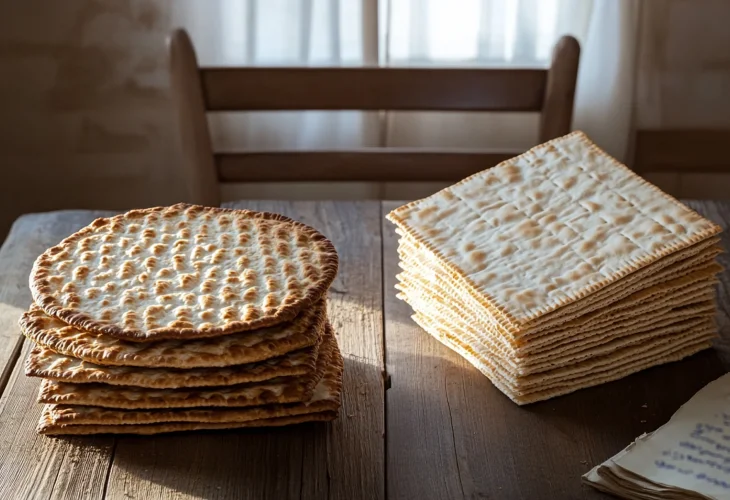Passover
The Untold Story of the Square Matzo on Your Seder Plate
When machine-made matzot were first introduced, they sparked a passionate halachic debate across Europe

Today, it's common to see square, machine-made matzot alongside the traditional round, hand-made ones. For many, it’s just part of what Passover looks like. But when machine-made matzot were first introduced, they caused a surprising and intense debate within the Jewish world.
This all began in 1858, about 160 years ago. Actually, the first matzo-making machine was developed around 1838 by a Jewish man named Isaac Singer, who lived near Strasbourg, France. His invention flattened matzo dough between two rollers, producing large sheets that were then cut into the familiar round shape. At the time, the dough was still kneaded by hand. This method was approved as kosher by Rabbi Joseph, the head of the rabbinical court (Av Beit Din) of Berlin, and the matzot became accepted in France and Germany.
Over time, industrial production advanced. Dough mixing became mechanical, the cutting process became automatic and square, and the matzot began to look noticeably different from the traditional ones. As the new method spread to other countries, it sparked a wide-ranging halachic (Jewish legal) discussion.
The fiercest debate took place in Galicia (now part of Poland and Ukraine). Some rabbis there supported the new matzot and even claimed they were more reliable. Since machines worked precisely and without human error, they saw this as an improvement. Supporters included great scholars like Rabbi Joseph Saul Nathanson of Lviv (author of Shoel U-Meishiv), Rabbi Jacob Ettlinger (Aruch La-Ner), Rabbi Israel Lipschitz, and Rabbi Benjamin Sofer, the grandson of the Chatam Sofer.
But many others strongly opposed the idea, especially leading Chassidic rabbis. Among them were Rabbi Yitzchak Meir Alter (the Chiddushei HaRim) and the Divrei Chaim of Sanz. They believed matzot must be carefully “watched” to avoid leavening (chametz), something that only a person, not a machine could do. They felt the mitzvah (commandment) of matzah should involve personal effort and spiritual intention (kavanah), which a machine could not provide. They also worried machines might be run by unqualified individuals, or that the matzot wouldn’t be made properly “for the sake of the mitzvah.”
In that same year, 1858, the rabbis of Krakow permitted machine-made matzot, partly to help poor families who couldn’t afford the expensive hand-made ones. But just before Passover, several of Krakow’s rabbis passed away. Rabbi Shlomo Kluger of Brody saw this as a heavenly protest. He immediately published a book called Modaa Rabba LeOrayta, which collected strong arguments against machine-made matzot. Some rabbis even went so far as to say these matzot were actual chametz.
Rabbi Nathanson of Lviv couldn’t accept such a harsh claim. After all, he argued, this was a matter of stringency (chumra), not a case of people eating real chametz on Passover. In response, he published a counter-book titled Bitul Modaa, in which he addressed each argument and defended the use of machine-made matzot. He ended his book with a strong statement: “Everything the prohibitors have written is false in all their assertions; they are false, and their words are false.”
The debate was sharp and public. Jewish newspapers like HaMagid printed letters and arguments from rabbis and scholars on both sides over several years.
In the end, most Jewish communities accepted machine-made matzot as kosher and permitted for general use. However, among Chassidic groups and the students of the Chazon Ish, the custom to avoid them remains strong. Some consider them inappropriate for use during the Seder night, while others actually prefer them, seeing machines as more precise and less prone to error.
Still, on the first night of Passover, most observant Jews use hand-made, round matzot for the mitzvah of eating the first kezayit (olive-sized portion) of matzah. That’s because the matzah must be made “for the sake of the mitzvah,” and traditionally, we associate that intention with a human being and not a machine.
Today, whether you choose square or round matzot, machine-made or hand-made, you're continuing a centuries-old tradition rooted in deep meaning, halachic thought, and communal values.
Happy Passover!

